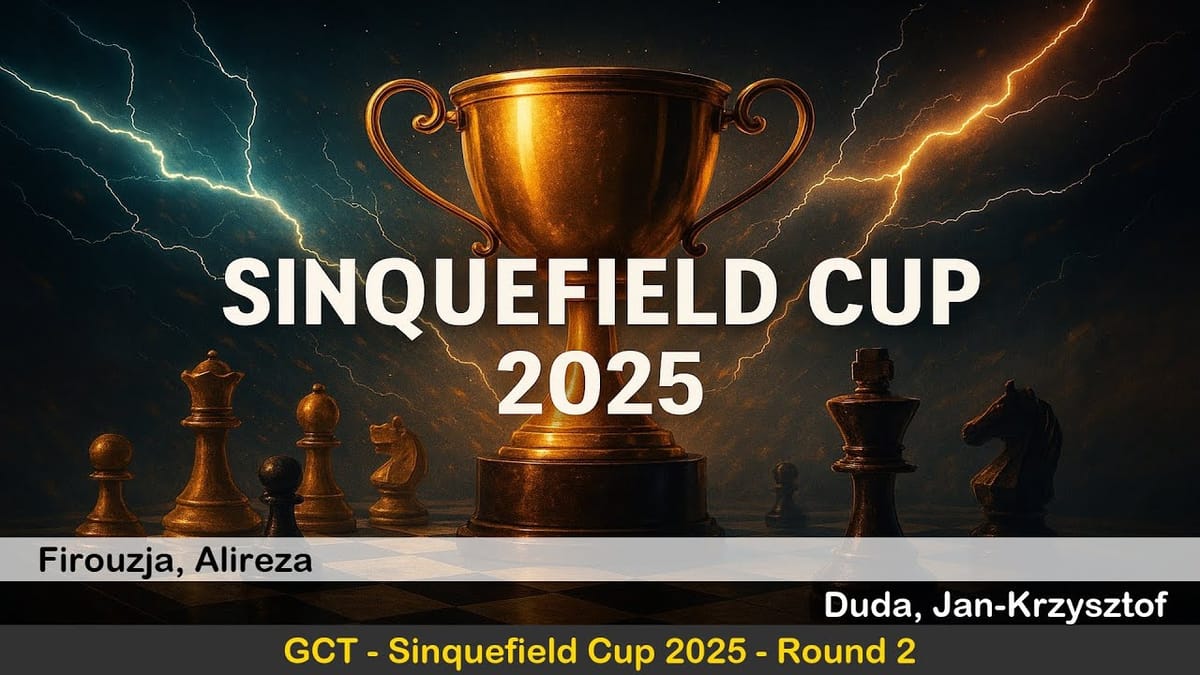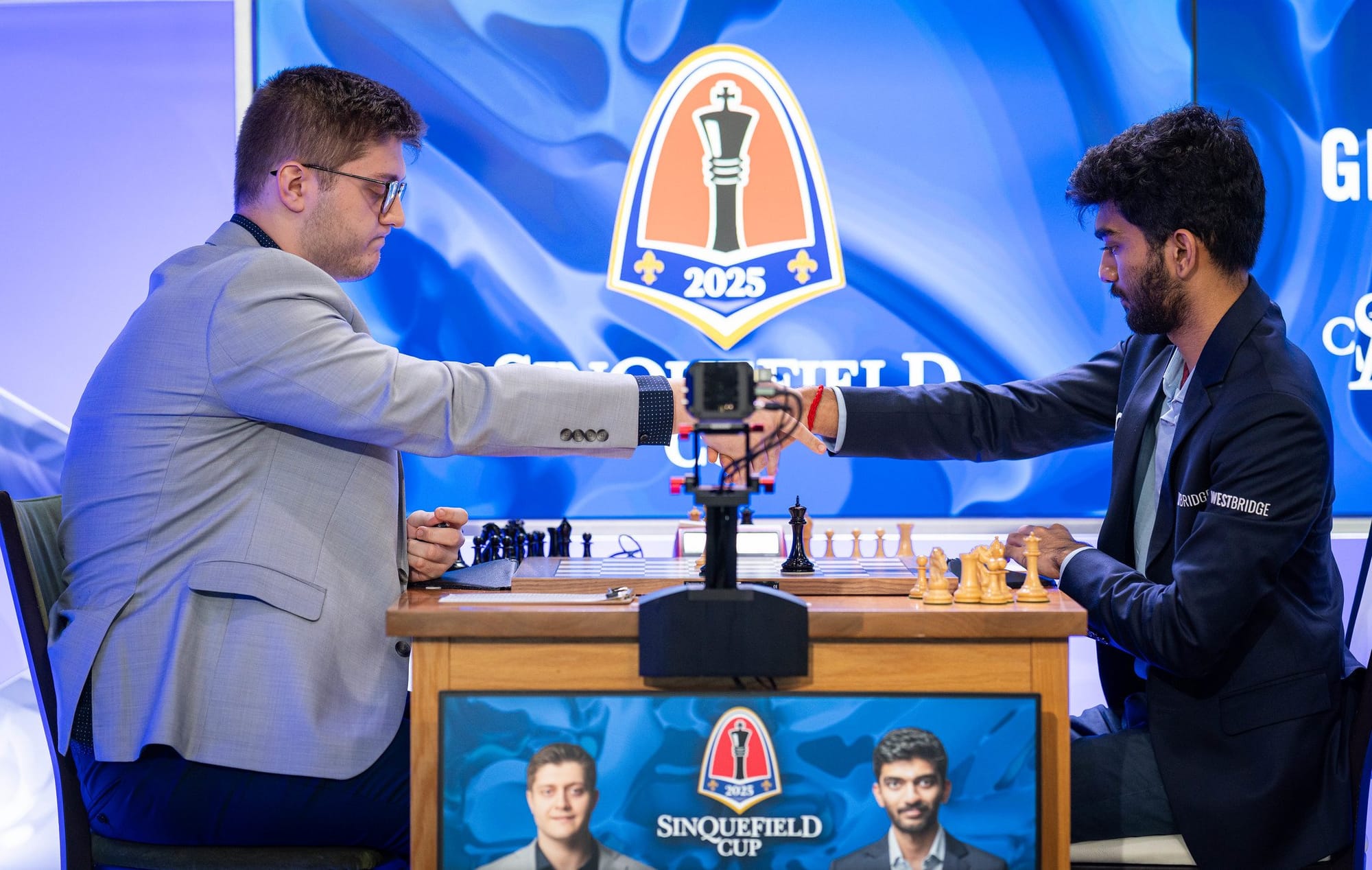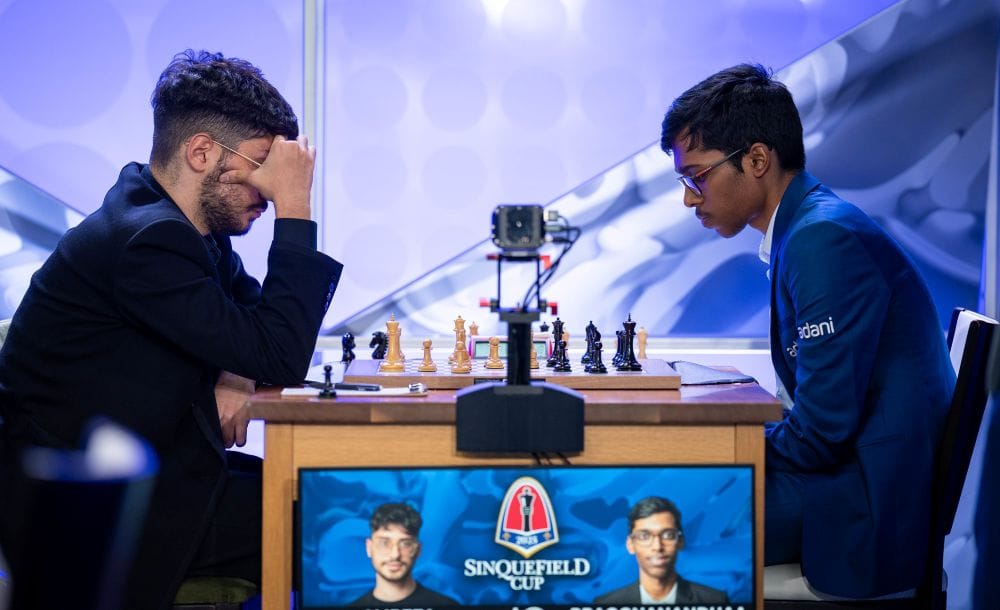Sinquefield Cup 2025: Praggnanandhaa’s Ascent & The New Order of World Chess
R. Praggnanandhaa’s stunning win over Alireza Firouzja reshapes the Sinquefield Cup 2025 leaderboard, cementing his status as a top-tier chess prodigy.

Written by Lavanya, Intern, Allegedly The News
ST. LOUIS, August 27, 2025
The atmosphere in the Saint Louis Chess Club is electric, thick with the tension of high-stakes classical chess. The 2025 Sinquefield Cup, the final and most prestigious classical event of the Grand Chess Tour, has delivered on its promise of drama and spectacle. At the center of it all is the brilliant young Indian Grandmaster, R. Praggnanandhaa, whose decisive victory over French prodigy Alireza Firouzja in Round 7 has sent shockwaves through the chess world. This isn't just a highlight reel moment; it's a pivotal shift in the narrative of modern chess, where two of the game’s most exciting talents are battling for supremacy. This victory not only propelled Praggnanandhaa into a joint lead with American superstar Fabiano Caruana but also highlighted the contrasting fortunes of India's top players, with reigning World Champion D. Gukesh facing a difficult tournament and a steep drop in the standings.
The Game of the Tournament: Praggnanandhaa vs. Firouzja
The Round 7 clash between R. Praggnanandhaa and Alireza Firouzja was a highly anticipated showdown. It pitted two players, born just a few years apart, who are widely seen as the future of world chess. Firouzja, playing with the white pieces, opened with a seemingly innocuous Rossolimo Variation against Praggnanandhaa’s Sicilian Defense. This choice, at first, seemed aimed at avoiding the deep and complex theoretical debates of the main Sicilian lines. However, Praggnanandhaa, with his signature deep preparation and unshakeable composure, was more than ready.
The game evolved into a subtle positional struggle, where both players maneuvered their pieces with great care. Firouzja’s strategy revolved around creating weaknesses in black’s pawn structure, but his plans were masterfully thwarted by Praggnanandhaa. The Indian prodigy’s pieces found their perfect coordination, and his light-squared bishop became a dominant force on the board. A critical juncture was reached when Firouzja, attempting to gain a temporary advantage, overextended his position. Praggnanandhaa seized the moment with a series of precise moves that beautifully exploited Firouzja's miscalculation. The Frenchman, under immense time pressure and facing a position that was rapidly deteriorating, made a critical blunder on move 25, allowing Praggnanandhaa to deliver a crushing blow that led to an immediate resignation. The game ended in a mere 27 moves, a shockingly swift defeat for a player of Firouzja’s caliber. This was Praggnanandhaa's first classical victory against Firouzja, a historical moment that not only earned him a full point but also a significant psychological edge in their rivalry.
For Firouzja, this defeat was a major setback. His tournament has been a rollercoaster of high-risk, high-reward play, and this time, the risk did not pay off. The loss to Praggnanandhaa, and a subsequent defeat in Round 8 to Nodirbek Abdusattorov have all but dashed his hopes for a top finish in the Sinquefield Cup and a secure spot in the GCT Finals.
An Unfortunate Turn for the World Champion: Gukesh’s Hard-Fought Loss to Wesley So
While Praggnanandhaa was celebrating his victory, his compatriot and the reigning World Champion, D. Gukesh, was enduring a painful defeat. In a clash against the ever-solid American Grandmaster Wesley So, Gukesh, playing with the black pieces, opted for the Berlin Defense, a famously drawish opening. However, Gukesh, in a clear attempt to play for a win and recover from an earlier tournament stumble, deviated from the well-trodden paths. His ambitious play, intended to create imbalances, was met with Wesley So’s trademark clinical precision.
So, a master of squeezing advantages out of seemingly equal positions, calmly navigated the complexities that arose. Gukesh's aggressive pawn push on the queenside, a move intended to generate counterplay, was deftly neutralized by So. The American Grandmaster, demonstrating a deep strategic understanding, seized control of the central squares and eventually won a crucial pawn. From that point on, the game was a slow and painful grind for Gukesh. He systematically converted his advantage, leaving Gukesh with no realistic counterplay. The game concluded in 38 moves with Gukesh’s resignation.
This loss was particularly significant. It was a stark reminder of the fine margins that separate victory and defeat at this level. Gukesh’s desire to win, a trait that has served him so well, was exploited by a veteran who excels at punishing overambitious play. This defeat leaves Gukesh with a mountain to climb to salvage his Sinquefield Cup campaign and his chances of qualifying for the Grand Chess Tour Finals. He now sits in the lower half of the standings, a position he is unaccustomed to. Wesley So, on the other hand, proved why he is one of the most respected players in the world, with his win catapulting him into the chase for the top spot.

The Grand Chess Tour Leaderboard: A New Reality
The results of Round 7 and the subsequent Round 8 have completely reshaped the Grand Chess Tour leaderboard. The battle for the coveted spots in the GCT Finals is now a tense, multi-player race.
Current Standings (After Round 8):
- 1-2: Fabiano Caruana, R. Praggnanandhaa (5.0/8 points each)
- 3-4: Wesley So, Levon Aronian (4.5/8 points each)
- 5-7: Jan-Krzysztof Duda, Maxime Vachier-Lagrave, Samuel Sevian (4.0/8 points each)
- 8-9: D. Gukesh, Alireza Firouzja (3.0/8 points each)
- 10: Nodirbek Abdusattorov (2.0/8 points)
Praggnanandhaa’s rise to the top of the leaderboard is a testament to his consistent high-level performance throughout the year. Having already won the Superbet Chess Classic in Romania, his strong showing here puts him in a commanding position to secure his place in the GCT Finals. The story for Gukesh, however, is a somber one. His hopes for the GCT Finals have been severely diminished, and he faces a crucial test of character in the final rounds. The final round will feature a heavyweight clash between the two leaders, Caruana and Praggnanandhaa, while Wesley So will also have a chance to challenge for the title.
The Strategic Brilliance of Wesley So: A Lesson in Restraint
Wesley So's victory over Gukesh was a masterclass in positional chess. Unlike Gukesh, who sought to create sharp and complex positions, So's approach was one of measured, controlled aggression. He avoided the typical simplified lines of the Berlin Defense and instead played for a subtle advantage in the middlegame. This decision, to avoid a pre-ordained draw and instead force the opponent to find their own creative solutions, proved to be the key to his success.
So’s play was a lesson in punishing over-ambition. Gukesh’s attempt to generate tactical possibilities with his pawn advances created small but exploitable weaknesses. So, with his meticulous calculation and deep positional understanding, he systematically capitalized on these weaknesses. He built up his advantage pawn by pawn and then piece by piece until Gukesh’s position was untenable. The game highlighted the stark difference in styles between the two players: Gukesh, a player of explosive genius and raw calculation, and So, a player of strategic patience and flawless technique. For Gukesh, this game offers a crucial learning opportunity. He must now find a way to balance his aggressive instincts with the patience and positional accuracy required to compete with players like So at the very top.
A Journey to the Top: The Evolution of R. Praggnanandhaa
Praggnanandhaa's exceptional performance at the Sinquefield Cup is the culmination of a meteoric rise that has captivated the chess world. It was not long ago that he was known primarily as one of the youngest Grandmasters in history. Today, he is a force to be reckoned with. His journey has been one of continuous improvement, marked by an expansion of his opening repertoire, a refinement of his positional play, and a newfound mental toughness.
His victory against Firouzja was not an isolated incident. Throughout the tournament, he has showcased a remarkable ability to find a way to win or at least hold on. His draw against Wesley So in Round 8, for instance, was another display of his resilience, where he expertly defended a difficult endgame to secure a crucial half-point. Praggnanandhaa's ability to dominate a player of Firouzja's caliber with the black pieces is a clear indication that he is now operating at a level that puts him in the conversation for the world's elite. He is no longer just a "prodigy" but a seasoned professional with the skill and nerve to compete for any title.

The Unraveling of Alireza Firouzja: A Study in High-Risk Chess
Alireza Firouzja, a player of immense talent and a reputation for brilliant, attacking chess, has had a tournament to forget. After a solid start, his play has become erratic, and his losses in the latter half of the event have exposed vulnerabilities in his game. His defeat to Praggnanandhaa was a direct consequence of his over-optimistic play, and his subsequent loss to Abdusattorov, a player at the bottom of the standings, was even more telling. In that game, Firouzja, despite a promising position, miscalculated in the late middlegame and was punished with clinical efficiency.
Firouzja's biggest challenge appears to be his clock management and his tendency to take unnecessary risks in slightly worse positions. While his high-stakes style has led to some of his most brilliant victories, it has also led to his most painful defeats. For him to recover and reclaim his place among the world’s elite, he must find a way to rein in his most adventurous instincts and combine them with the rock-solid strategic play that marks the world's most consistent players.
The Significance for World Rankings & Future Championships
The Sinquefield Cup's influence extends far beyond its prize money. As the final classical tournament of the GCT, it is a crucial battleground for world ranking points. A strong performance here can significantly boost a player’s Elo rating, moving them up the FIDE list and putting them in contention for future world championships. Praggnanandhaa's performance has not only cemented his place among the top players but has also put him within striking distance of the very top. For Gukesh, the tournament has been a reality check. The pressure of being the World Champion is immense, and his recent losses will be closely scrutinized. How he recovers from this and adapts his play will be a defining factor in his reign as champion.
A Changing of the Guard
The 2025 Sinquefield Cup has been a tournament of high drama, brilliant chess, and, most importantly, a clear sign of a new order. The era of a few dominant champions is giving way to a new generation of fierce and talented competitors, led by the likes of Praggnanandhaa. His victory over Firouzja wasn't just a game; it was a statement. It was a declaration that he is here to stay and that he is a threat to anyone, anywhere.
What we are witnessing is a generational shift. The high-stakes battles between these young prodigies are not just for a title or prize money; they are shaping the future of chess itself. The games played here will be studied for years to come, offering insights into the evolving strategies and the incredible mental fortitude required to succeed at the highest level.
What Does This Mean for the Future of Chess?
The rise of players like Praggnanandhaa and Gukesh is a testament to the thriving chess scene in India and globally. It shows that the game is becoming more competitive and more exciting than ever before. What do you think this new generation of players, with their aggressive and fearless styles, means for the future of chess? Are we entering a golden age of dynamic, tactical battles that will enthrall audiences for years to come? Or will we see a return to the more classical, controlled style of play as these young players mature? The answer, as the Sinquefield Cup has shown, is anything but certain.
Sources
Chess.com, ChessBase India, Times of India, and official Grand Chess Tour broadcasts and interviews.




